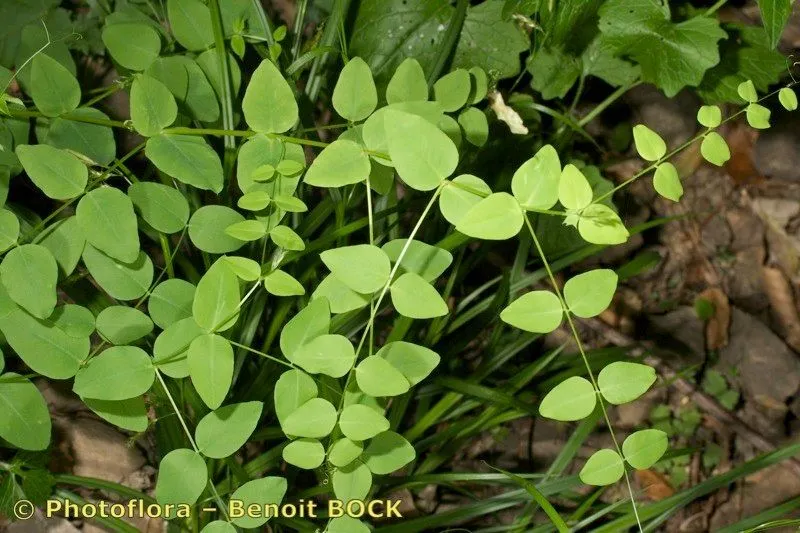
Author: L.
Bibliography: Sp. Pl.: 734 (1753)
Year: 1753
Status: accepted
Rank: species
Genus: Vicia
Vegetable: False
Observations: Europe to W. Siberia and Caucasus
Pea vetch, scientifically known as Vicia pisiformis, is a perennial climbing plant that belongs to the Fabaceae family. Originating from various regions across Europe, Western Siberia, and the Caucasus, this species has thrived in diverse landscapes, demonstrating its adaptive prowess.
Typically found in woodlands and scrubby areas, Pea vetch showcases slender, vining stems that can reach considerable lengths as they seek out support from surrounding vegetation. Its tendrils allow it to securely anchor onto nearby plants, creating a network of interconnected greenery that serves as both shelter and a passageway for forest-dwelling insects and small animals.
The leaves of Vicia pisiformis are compound, usually comprising several pairs of leaflets that culminate in a curling, grasping tendril. This structural adaptation is not merely for support; it enables the plant to maximize light absorption by elevating itself above the competition on the forest floor. The inherent beauty of these leaves lies in their delicate design and the seamless way they integrate with the plant’s overall growth habit.
One of the most captivating features of Pea vetch is its floral display. The plant produces racemes of small, yet striking, flowers that are typically purple or violet. These blossoms are not just visually appealing; they play a crucial role in the ecosystem by attracting pollinators like bees, which, in turn, facilitate the plant’s reproductive cycle. Following the blooming period, Vicia pisiformis develops distinctive pea-like pods that encapsulate its seeds, contributing to both the continuity of its species and the diet of various animals.
Intriguingly, Pea vetch has been recognized in botanical literature for centuries, with its initial description listed in the esteemed publication “Species Plantarum” in 1753 by the renowned botanist Carl Linnaeus, denoted by the abbreviation “L.” This historical reference underscores the plant’s longstanding intrigue and significance within the botanic community.
In addition to its ecological roles, Vicia pisiformis has been studied for its interactions with soil nutrients, particularly nitrogen. As a member of the Fabaceae family, it contributes to soil health through nitrogen fixation, a process facilitated by symbiotic relationships with soil bacteria. This natural enrichment is beneficial to surrounding plant communities, making Pea vetch an important player in sustaining ecosystem fertility.
In conclusion, Pea vetch (Vicia pisiformis) is more than just a botanical specimen; it is a resilient and adaptable species with a rich history and an essential role in its natural habitat. From its climbing foliage and charming flowers to its ecological contributions, this plant exemplifies the intricate connections that sustain our natural world.
Deu: erbsen-wicke
Nor: ertevikke
Nno: ertevikke
Nob: ertevikke
Swe: hernevirna, ärtvicker
Fin: hernevirna
Eng: pale-flower vetch, pea vetch
Lav: zirņveida vīķis
Dan: ærte-vikke
En: Pea vetch, Pale-flower vetch, Pale-flowered Vetch, Peaseshaped-vetch
Ar: بيقية بازلائية
Hy: Վիկ ոլոռնանման
Be: Гарошак гарохападобны
Bg: Грахова глушина
Hr: Graškolika grahorica
Cs: Vikev hrachovitá
Da: Ærte-vikke
Nl: Erwtbladige wikke
Fi: Hernevirna
Fr: Vesce à feuilles de pois, Vesce faux pois
De: Erbsen-Wicke, Erbsen Wicke, Gelbe-Waldwicke
It: Veccia pisellina
Kk: Бұршақтәрізді сиыр жоңышқа
Lv: Zirņveida vīķis
Li: Ertwèk
Lt: Žirnialapis vikis
No: Ertevikke
Nb: Ertevikke
Nn: Ertevikke
Ru: Горошек гороховидный
Sv: Ärtvicker, Hernevirna
Taken Jul 18, 2021 by Markus (cc-by-sa)
Taken Jul 15, 2005 by Photoflora – Benoit BOCK (©)
Taken May 24, 2020 by Carlos Kater (cc-by-sa)
Taken Jul 15, 2018 by Photoflora – Benoit BOCK (©)
Taken Jun 25, 2020 by V Rad (cc-by-sa)
Taken Jun 1, 2022 by klara kucerova (cc-by-sa)
Taken Jun 16, 2021 by Eric Larsen (cc-by-sa)
Taken Jun 2, 2022 by onbotanical (cc-by-sa)
Taken Aug 15, 2005 by Photoflora – Benoit BOCK (©)
Taken May 15, 2014 by Photoflora – Benoit BOCK (©)
Taken Jul 15, 2005 by Photoflora – Benoit BOCK (©)
Taken Jul 15, 2018 by Photoflora – Benoit BOCK (©)
Taken Aug 15, 2014 by Photoflora – Jean-Luc TASSET (©)
Taken Aug 15, 2014 by Photoflora – Jean-Luc TASSET (©)
Taken Jan 1, 1970 by Photoflora – L’Abbé COSTE (©)
Taken Jul 15, 2005 by Photoflora – Benoit BOCK (©)
Taken Aug 15, 2014 by Photoflora – Benoit BOCK (©)
Taken Aug 15, 2014 by Photoflora – Jean-Luc TASSET (©)
Taken Aug 15, 2009 by Photoflora – Benoit BOCK (©)
Taken Aug 15, 2014 by Photoflora – Benoit BOCK (©)
Taken Jul 15, 2018 by Photoflora – Benoit BOCK (©)
Taken Aug 15, 2014 by Photoflora – Jean-Luc TASSET (©)
Ph maximum: 8.0
Ph minimum: 7.5
Light: 6
Atmospheric humidity: 5
Bloom months: [‘may’, ‘jun’, ‘jul’]
Soil nutriments: 3
Family: Myrtaceae Author: (F.Muell.) K.D.Hill & L.A.S.Johnson Bibliography: Telopea 6: 402 (1995) Year: 1995 Status:…
Family: Rubiaceae Author: Pierre ex A.Froehner Bibliography: Notizbl. Bot. Gart. Berlin-Dahlem 1: 237 (1897) Year:…
Family: Sapindaceae Author: Koidz. Bibliography: J. Coll. Sci. Imp. Univ. Tokyo 32(1): 38 (1911) Year:…
Family: Asteraceae Author: A.Gray Bibliography: Pacif. Railr. Rep.: 107 (1857) Year: 1857 Status: accepted Rank:…
Family: Fabaceae Author: Medik. Bibliography: Vorles. Churpfälz. Phys.-Ökon. Ges. 2: 398 (1787) Year: 1787 Status:…
Family: Aspleniaceae Author: (Cav.) Alston Bibliography: Bull. Misc. Inform. Kew 1932: 309 (1932) Year: 1932…